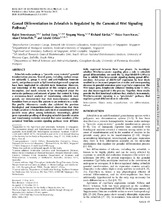Gonad differentiation in zebrafish is regulated by the canonical Wnt signalling pathway
Date
2014Author
Sreenivasan, Rajini
Jiang, Junhai
Wang, Xingang
Bartfai, Richard
Kwan, Hsiao, Y.
Christoffels, Alan
Orban, Laszlo
Metadata
Show full item recordAbstract
Zebrafish males undergo a ‘‘juvenile ovary-to-testis’’ gonadal transformation process. Several genes, including nuclear receptor subfamily 5, group A (nr5a) and anti-Mu¨ llerian hormone (amh), and pathways such as Tp53-mediated germ-cell apoptosis have been implicated in zebrafish testis formation. However, our knowledge of the regulation of this complex process is incomplete, and much remains to be investigated about the molecular pathways and network of genes that control it. Using a microarray-based analysis of transforming zebrafish male
gonads, we demonstrated that their transcriptomes undergo transition from an ovary-like pattern to an ovotestis to a testislike profile. Microarray results also validated the previous histological and immunohistochemical observation that there
is high variation in the duration and extent of commitment to the juvenile ovary phase among individuals. Interestingly, global gene expression profiling of diverging zebrafish juvenile ovaries and transforming ovotestes revealed that some members of the canonical Wnt/beta-catenin signaling pathway were differentially expressed between these two phases. To investigate whether Wnt/beta-catenin signaling plays a role in zebrafish gonad differentiation, we used the Tg (hsp70l:dkk1b-GFP)w32 line to inhibit Wnt/beta-catenin signaling during gonad differentiation. Activation of dkk1b-GFP expression by heat shock resulted in an increased proportion of males and corresponding decrease in gonadal aromatase gene (cyp19a1a) expression. The Wnt target gene, lymphocyte enhancer binding factor 1 (lef1), was also down-regulated in the process. Together, these results provide the first functional evidence that, similarly to mammals,
Wnt/beta-catenin signaling is a ‘‘pro-female’’ pathway that regulates gonad differentiation in zebrafish.

